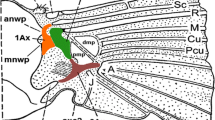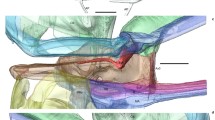Abstract
The wing articulation sclerites, as well as wing base environment, of phylogenetically distant Psylloidea taxa were examined by optical and electron microscopy in order to estimate the phylogenetic significance of observed morphological patterns. The basiradial bridge is strongly developed and links the fused humeral plate, basisubcostale, basiradiale and second axillary sclerite to the fused veins R + M + Cu. The proximal median plate has a vertical orientation, which may have a role in moving the wing forward and backward. The weak sclerotization posteriad of the second axillary sclerite and anteriad to the third axillary sclerite facilitates the backward movement of the wing. The horizontal hinge (= basal hinge), the vertical hinge and the torsional hinge are the most important fold- and flexion-lines for the mobility of the wing, whereas humeral folds and the anterior axillary fold-line play a minor role. The basalare presents two horns or processes that are autapomorphic traits for the superfamily Psylloidea. The monophyly of Psylloidea is also supported by the absence of the subalare, of the median notal wing process and of the anterior arm of the third axillary sclerite (lacking articulation with second axillary sclerite). Major interspecific variations are observed in tegula, first axillary sclerite and basalare shape and size. The second distal median plate is absent in Homotoma ficus (Homotomidae) and Glycaspis brimblecombei (Spondyliaspidinae), whereas it is present in Calophya schini (Calophyidae) and Psylla buxi (Psyllinae/Arytaininae); the presence of this sclerite could be a synapomorphy linking Calophyidae and the “psyllid assemblage”.




Similar content being viewed by others
References
Betts CR (1986) The comparative morphology of the wings and axillae of selected Heteroptera. J Zool 1:255–282
Brodskiy AK (1992) Structure, function and evolution of the terga of wing-bearing segments of insects. II. Organizational features of the terga in different orders of insects. Entomol Rev 71(9):8–28
Brodsky AK (1994) The evolution of insect flight. Oxford University Press, Oxford
Browne DJ, Scholtz CH (1995) Phylogeny of the families of Scarabaeoidea (Coleoptera) based on characters of the hindwing articulation, hindwing base and wing venation. Syst Entomol 20:145–173
Browne DJ, Scholtz CH (1998) Evolution of the scarab hindwing articulation and wing base: a contribution toward the phylogeny of the Scarabaeidae (Scarabaeoidea: Coleoptera). Syst Entomol 23(4):307–326
Browne DJ, Scholtz CH, Kukalovà-Peck J (1993) Phylogenetic significance of wing characters in the Trogidae (Coleoptera: Scarabaeoidea). Afr Entomol 1(2):195–206
Burckhardt D (2005) Biology, ecology, and evolution of gall-inducing Psyllids (Hemiptera: Psylloidea). In: Raman A, Schaefer CW, Withers TM (eds) Biology, ecology, and evolution of gall-inducing arthropods. Science Publishers, Enfield, pp 143–157
Carayon J (1969) Emploi du noir chlorazol en anatomie microscopique des Insectes. Ann Soc Entomol Fr 5:179–193
Chapman RF (1969) The insects. Structure and function. The English Universities Press LTD, London
Clark LR (1962) The general biology of Cardiaspina albitextura (Psyllidae) and its abundance in relation to weather and parasitism. Aust J Zool 10(4):537–586
Crampton GC (1914) On the misuse of the terms parapteron, hypopteron, tegula, squamala, patagium and scapula. J N Y Entomol Soc 22:248–261
Crawford DL (1914) A monograph of the jumping plant-lice or Psyllidae of the new world. Smithsonian Institution, United States National Museum Bulletin, 85. Government Printing Office, Washington
Fischer H, Ebert E (1999) Tegula function during free locust flight in relation to motor pattern, flight speed and aerodynamic output. J Exp Biol 202(6):711–721
Frye MA, Gray JR (2005) Mechanosensory integration for flight control in insects. In: Christensen TA (ed) Methods in insect sensory neuroscience. CRC Press, Boca Raton, pp 107–128
Gullan PJ, Kosztarab M (1997) Adaptations in scale insects. Annu Rev Entomol 42:23–50
Hodkinson ID (1974) The biology of the Psylloidea (Homoptera): a review. Bull Entomol Res 64:325–339
Hollis D (2004) Australian Psylloidea: jumping plantlice and lerp insects. Australian Biological Resources Study, Canberra
Hörnschemeyer T (1998) Morphologie und Evolution des Flügelenks der Coleoptera und Neuropterida. Bonner Zoologische Monographien, 43. Zoologisches Forschungsinstitut und Museum Alexander Koenig, Bonn
Hörnschemeyer T (2002) Phylogenetic significance of the wing-base of the Holometabola (Insecta). Zoolog Scripta 31(1):17–29
Ivanov VD, Kozlov MV (1987) Comparative analysis of pterothoracic musculature of caddis-flies (Insecta Trichoptera) (in Russian). Zool Zh 66(10):1484–1498
Knight KL, Laffoon JL (1970) A mosquito taxonomic glossary. IV. Adult thoracic appendages. Mosq Systemat Newslett 2(4):165–177
Kukalovà-Peck J (1991) Fossil history and the evolution of hexapod structures. In: Naumann ID, CSIRO (ed) The insects of Australia, 2nd edn. Melbourne University Press, Melbourne, Australia, pp 141–179
Lefeuvre JC (1969) Recherches sur les organes alaires des Blattaria. PhD Thesis. Université de Rennes, Rennes, France
Maggenti AR, Gardner SL (2005) Online dictionary of invertebrate zoology, Version 2.0. Posted October 20 2005. http://digitalcommons.unl.edu
Matsuda R (1963) Some evolutionary aspects of the insect thorax. Annu Rev Entomol 8:59–76
Matsuda R (1970) Morphology and evolution of the insect thorax. Memoirs of the Entomological Society of Canada, 76. Entomological Society of Canada, Ottawa
Matsuda R (1979) Morphologie du thorax et des appendices thoraciques des insectes. In: Grassé P-P (ed) Traité de Zoologie. T. VIII. Fasc. II. Masson, Paris, France, pp. 1–289
Ouvrard D. (2002) Systématique phylogénétique des Hemiptera Psylloidea: morphologie comparée du thorax et structures secondaires des ARNr 18S. Bull Soc Zool Fr 127(4):345–357
Ouvrard D, Bourgoin T, Campbell BC (2002) Comparative morphological assessment of the psyllid pleuron (Insecta, Hemiptera, Sternorrhyncha). J Morphol 252(3):276–290
Owen WB (1977) Morphology of the thoracic skeleton and muscles of the mosquito, Culiseta inornata (Williston), (Diptera: Culicidae). J Morphol 153(3):427–460
Pringle JWS (1957) Insect flight. Cambridge monographs in experimental biology, 9. Cambridge University Press, Cambridge
Rheuben M, Kammer A (1987) Structure and innervation of the third axillary muscle of Manduca relative to its role in turning flight. J Exp Biol 131(1):373–402
Taylor LH (1918) The thoracic sclerites of Hemiptera and Heteroptera. Ann Entomol Soc Am 11(3):225–254
White IM, Hodkinson ID (1985) Nymphal taxonomy and systematics of the Psylloidea (Homoptera). Bull Nat Hist Mus (Entomol) 50(2):153–301
Wootton RJ (1979) Function, homology and terminology in insect wings. Syst Entomol 4:81–93
Wootton RJ (1992) Functional morphology of insect forewings. Annu Rev Entomol 37(1):113–140
Yoshizawa K (2002) Phylogeny and higher classification of suborder Psocomorpha (Insecta: Psocodea: ‘Psocoptera’). Zool J Linn Soc 136(3):371–400
Yoshizawa K (2005) Morphology of Psocomorpha (Psocodea: ‘Psocoptera’). Insecta Matsumurana NS 62:1–44
Yoshizawa K, Saigusa T (2001) Phylogenetic analysis of paraneopteran orders (Insecta: Neoptera) based on forewing base structure, with comments on monophyly of Auchenorrhyncha (Hemiptera). Syst Entomol 26:1–13
Acknowledgments
We are grateful to Rebeca Álvarez Zagoya, David Hollis and Kathleen L. Chan for providing some of the specimens used in this investigation. We also thank Imre Foldi and Gérard Mascarell for providing help and advice in scanning electron microscopy. Gilbert Hodebert made the line drawing and Laurent Fauvre helped in preparing the illustrations. This work was supported in part by the European Community’s Sixth Framework Programme to D.O. (Marie Curie Outgoing International Fellowship).
Author information
Authors and Affiliations
Corresponding author
Rights and permissions
About this article
Cite this article
Ouvrard, D., Burckhardt, D., Soulier-Perkins, A. et al. Comparative morphological assessment and phylogenetic significance of the wing base articulation in Psylloidea (Insecta, Hemiptera, Sternorrhyncha). Zoomorphology 127, 37–47 (2008). https://doi.org/10.1007/s00435-007-0049-x
Received:
Accepted:
Published:
Issue Date:
DOI: https://doi.org/10.1007/s00435-007-0049-x




